The Exhibition: Seton Hall University, New Jersey
Exhibition Showing: Seton Hall University, New Jersey, USA
22nd January - 2nd April 2006
 Seton Hall’s Walsh Library, built in 1994 and located in the heart of the campus, is a four-storey, 155,000 square-foot structure, named in honour of the Board of Regents Chairman and University benefactor Frank E.Walsh and his wife, Mary D.Walsh.
Seton Hall’s Walsh Library, built in 1994 and located in the heart of the campus, is a four-storey, 155,000 square-foot structure, named in honour of the Board of Regents Chairman and University benefactor Frank E.Walsh and his wife, Mary D.Walsh.
 Seton Hall University is one of the leading Catholic universities in the USA and is home to the Sister Rose Thering Endowment. Through the initiative of Sister Rose* herself, aided by our very own Alan Silberstein, an Endowment Board member, that the Jews of Częstochowa” came to Seton Hall.
Seton Hall University is one of the leading Catholic universities in the USA and is home to the Sister Rose Thering Endowment. Through the initiative of Sister Rose* herself, aided by our very own Alan Silberstein, an Endowment Board member, that the Jews of Częstochowa” came to Seton Hall.
On Sunday, 22nd January, almost 300 people were welcomed to the Official Opening of the Exhibition by Luna Kaufman, Chairman of the Board of the Sister Rose Thering Endowment and Associate Professor Dr.Richard Stern, representing the Walsh Library.
Guests were entertained by Cantor Daniel Neiden who sang excerpts from Virgilio’s Prayer and The Voyage of the Black Madonna by John La Barbera.

From left: Jo Ann Cotz (Exhibition Curator at Seton Hall),
Marilyn Zirl (Endowment Administrator),
Luna Kaufman, Sigmund Rolat,
Lea Wolinetz,
Alan Silberstein,
Consul Marek Skulimowski




Deputy Polish Consul in New York City, Marek Skulimowski, spoke briefly followed by the Exhibition’s Sponsors Alan Silberstein and Sigmund Rolat. Lea Wolinetz, Chief Exhibition Coordinator and a second-generation Częstochowianka, gave a short address and closed the official part of the Opening.

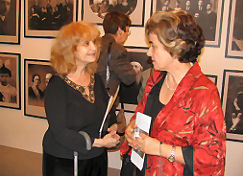



From left: Elizabeth Mundlak, Lea Wolinetz, Sam Bida (from Częstochowa),
his granddaughter and daughter Anna Bida Fleischer
* Sister Rose Thering, O.P., Ph.D., Professor Emerita at Seton Hall, is a Dominican nun who has dedicated her life to preserving the historical link and advocating the common purpose of Jews and Christians throughout the world. The Sister Rose Thering Endowment was established in 1993 in her honour to help provide scholarship assistance for teachers to take graduate level courses in Jewish Christian and Holocaust studies. It also develops curricular resources and presents workshops for teachers in public, private and parochial schools. More than 350 teachers and an estimated 150,000 students throughout New Jersey have benefited from the endowment since its inception.
Seton Hall University, nationally known and respected as a leading Catholic university, embraces students of all races and religion. For nearly 150 years, Seton Hall has been a catalyst for leadership, developing the whole student, mind, heart and spirit. It combines the resources of a large university with the personal attention of a small liberal arts college.
The Webmaster wishes to thank Alex Wolinetz and Iwona Hoffman
for the photographs that appear on this page.
The Exhibition: New York City, New York
Exhibition Showing: New York City, New York, USA
2nd-10th November 2005
 The venue for the “Jews of Częstochowa” exhibition in New York City was the Consulate General of the Republic of Poland which is housed in a magnificent mansion that was once the home of banker J.P.Morgan.
The venue for the “Jews of Częstochowa” exhibition in New York City was the Consulate General of the Republic of Poland which is housed in a magnificent mansion that was once the home of banker J.P.Morgan.
 Built in the 1880’s, it is an elaborate Neo-classical French-style building with gilded mouldings, a graceful winding staircase and a beautiful painted ceiling in the ballroom.
Built in the 1880’s, it is an elaborate Neo-classical French-style building with gilded mouldings, a graceful winding staircase and a beautiful painted ceiling in the ballroom.
The official opening, held on Thursday, 3rd November, was attended by over 350 people.
After his formal remarks (in English), Shewach Weiss (pic right) could not help exclaiming (in Polish) how unbelievable it was for him to be standing there considering that he is a Holocaust survivor who became the Ambassador of the State of Israel to Poland and an honoured guest at an occasion hosted by the Polish Consul-General.




Other speakers at the opening included (from left) Sigmund Rolat (a sponsor of the Exhibition), Prof. Dr. hab. Jerzy Mizgalski (Curator of the Exhibition),
Prof.Feliks Tych (President, Jewish Historical Institute in Warsaw) and Dr.Tadeusz Wrona (President, City of Częstochowa).


Among guests invited from Poland were Rabbi Michael Shudrich (Chief Rabbi of Poland)
and Halina Wasilewicz (Chairwoman of TSKZ, Częstochowa).
Since the showings in Poland, the addition of the Polish students’ artwork to the Exhibition was powerful proof that it had reached and inspired a new generation in Poland to consider the role of Jews in their country’s history.
All Polish art schools now have the compulsory study of art “inspired by Jewish culture”. Also, the study of the Jews and the Holocaust is now compulsory study for students in all Polish high schools.
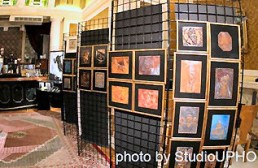




and also Sylvia Safer, Prof. Dr.Jerzy Mizgalski and Piotr Stasiak for their input.
The Exhibition: Houston, Texas
Exhibition Showing: Houston, Texas, USA
11th February - 29th July 2007
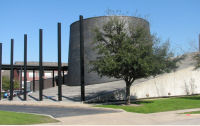 The Mincberg Gallery at the Holocaust Museum Houston, Morgan Family Centre, was the next home for our Exhibition on its tour around North America.
The Mincberg Gallery at the Holocaust Museum Houston, Morgan Family Centre, was the next home for our Exhibition on its tour around North America.
Since March 1996, the Museum’s mission has been to educate students and the public about the dangers of prejudice and hatred in society, focusing on the stories of Holocaust survivors living in the Houston metropolitan area.
The Official Opening of our Exhibition was attended by over 200 people representing many areas of Houston society and showed that the reputation of Texan hospitality was no exaggeration. The cocktail reception and Opening proceedings were conducted to perfection.
Our Częstochowa Exhibition was in illustrious company. It shared the limelight with the presigious Scream the Truth at the World – Emanuel Ringelblum and the Hidden Archive of the Warsaw Ghetto exhibition. Both were on view in the Mincberg gallery at the Museum until 29th July 2007.




The following morning saw a wonderful training session for the docents of the Museum. After all, what’s a successful Exhibition without docents? Sigmund gave a personal tour through the Exhibition and, with his usual charismatic style, motivated the group to tell our story to groups who would visit our exhibition over the following months.


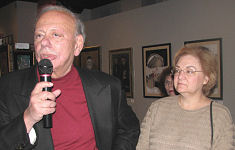

The Webmaster wishes to thank Lea Wolinetz for the words and Marilyn Levin for the photographs from which this page was compiled.
The Exhibition: Fort Lauderdale, Florida
Exhibition Showing: Fort Lauderdale, Florida, USA
3rd December 2006 - 29th January 2007
 The Alvin Sherman Library Gallery at Nova Southeastern University in Fort Lauderdale, Florida was the next stop for our Exhibition, The Jews of Częstochowa.
The Alvin Sherman Library Gallery at Nova Southeastern University in Fort Lauderdale, Florida was the next stop for our Exhibition, The Jews of Częstochowa.
 It was accompanied by the lnspired by Jewish Culture” art project, motivated by the Exhibition and created by students of the Malczewski School of Fine Arts in Częstochowa and throughout Poland.
It was accompanied by the lnspired by Jewish Culture” art project, motivated by the Exhibition and created by students of the Malczewski School of Fine Arts in Częstochowa and throughout Poland.
 Nova University is located on a beautiful 300 acre campus and has more than 25,000 students. It is the largest institution of higher education in the south-east and the sixth largest independent institution nationally. The Alvin Sherman Library, Research, and Information Technology Center is central to the University’s main campus – Fort Lauderdale.
Nova University is located on a beautiful 300 acre campus and has more than 25,000 students. It is the largest institution of higher education in the south-east and the sixth largest independent institution nationally. The Alvin Sherman Library, Research, and Information Technology Center is central to the University’s main campus – Fort Lauderdale.
 The Exhibition Opening was held on Sunday 3rd December in the Libary before over 300 Landsleit and their friends, with representatives of the Hebrew College, David Posnack JCC, Nova Southeastern University and the Holocaust Documentation and Education Center in Miami also in attendance.
The Exhibition Opening was held on Sunday 3rd December in the Libary before over 300 Landsleit and their friends, with representatives of the Hebrew College, David Posnack JCC, Nova Southeastern University and the Holocaust Documentation and Education Center in Miami also in attendance.

 Master of Ceremonies for the event was Dr Irv Rosenbaum, Vice-Chancellor, NSU Health Professions Division (pictured left), who welcomed everyone to the Exhibit and expressing how pleased the University was to host it.
Master of Ceremonies for the event was Dr Irv Rosenbaum, Vice-Chancellor, NSU Health Professions Division (pictured left), who welcomed everyone to the Exhibit and expressing how pleased the University was to host it.
World Society President, Sigmund Rolat, thanked Nova University for hosting our Exhibition and, in welcoming the many guests, noted with great pleasure the exceptional number of Częstochowa landsleit who were present at the Opening of this Exhibition.
Dr Rosenbaum also stated that this was the first event of its kind to be held in Nova University and said that there were plans for future Jewish-related events on campus in the near future.

 World Society Board Member,Alan Silberstein (pictured left), spoke of his experiences as a child of Holocaust survivors from Częstochowa. World Society Executive Director, Lea Wolinetz (pictured right), spoke of the special bond that we have to Częstochowa and our heritage and promised the survivors that their story will never be forgotten.
World Society Board Member,Alan Silberstein (pictured left), spoke of his experiences as a child of Holocaust survivors from Częstochowa. World Society Executive Director, Lea Wolinetz (pictured right), spoke of the special bond that we have to Częstochowa and our heritage and promised the survivors that their story will never be forgotten.
Other speakers at the Opening Polish-Jewish historical and social commentator Konstanty Gebert, President of the Holocaust Documentation and Education Center Harry A Levy and Director,Southeast Region, Hebrew College, Harold Wishna.



Mrs Rositta Kenigsberg, Executive Vice-President of the Holocaust Documentation and Education Centre, who was instrumental in helping us bring the Exhibition to Nova University, urged survivors present to contact the center and give a “living testimony”. Many of our Landsleit have already agreed to tell their stories to the Museum in Miami.




The Exhibition: Detroit, Michigan
Exhibition Showing: Detroit, Michigan, USA
16th July - 29th August 2006

 The first freestanding museum in the United States dedicated to the memory of the Holocaust, The Holocaust Memorial Center, in Detroit Michigan, was the venue for “The Jews of Częstochowa” exhibition in Detroit.
The first freestanding museum in the United States dedicated to the memory of the Holocaust, The Holocaust Memorial Center, in Detroit Michigan, was the venue for “The Jews of Częstochowa” exhibition in Detroit.
A gathering of 300 people attending the Opening of the Exhibition on Sunday 16th July, with Detroit’s Fox TV Channel 2 journalist, Lila Lazarus (pic right), as Master of Ceremonies. Two days earlier, Lila had interviewed Sigmund Rolat live on her news program.
 Other speakers at the Opening included Michigan Congressman Joe Knollenberg, Pawel Pietrasienski, Deputy Consul-General of the Republic of Poland in Chicago, and Ralph J.Gerson, a prominent Detroit area resident and President & Chief Executive Officer of Guardian International Corp. – a American company which has established a manufacturing plant in Częstochowa.
Other speakers at the Opening included Michigan Congressman Joe Knollenberg, Pawel Pietrasienski, Deputy Consul-General of the Republic of Poland in Chicago, and Ralph J.Gerson, a prominent Detroit area resident and President & Chief Executive Officer of Guardian International Corp. – a American company which has established a manufacturing plant in Częstochowa.




 World Society Executive Director, Lea Wolinetz, stressed the responsibility of Second Generation Landsleit to preserve the story of our forebears for future generations. She described the formation of the World Society as a direct outgrowth of this Exhibition and of the website – none of which would have happened without Sigmund Rolat’s energy and commitment.
World Society Executive Director, Lea Wolinetz, stressed the responsibility of Second Generation Landsleit to preserve the story of our forebears for future generations. She described the formation of the World Society as a direct outgrowth of this Exhibition and of the website – none of which would have happened without Sigmund Rolat’s energy and commitment.
Dr Thaddeus Radzilowski, Ph.D., President of the PIAST Institute, represented the local Polish-American community.
Others to speak included Rabbi Charles H. Rosenzveig, from the Holocaust Memorial Center and, of course, our own Sigmund Rolat and Alan Silberstein, sponsors of the exhibition.




The exhibition was prominent in the local media with theDetroit Free Press, the Detroit Jewish News and the Kalamazoo Gazette all running feature articles. Also, the Polish Weekly featured the exhibition in both English and Polish.
Sigmund Rolat appeared on television, interviewed live by both FOX TV and ABC and his documentary, As If It Were Yesterday has been aired on PBS (Detroit Public Television).
for the information from which this page was compiled.
The Exhibition: Washington D.C.
Exhibition Showing: Washington, D.C., USA
5th-9th December 2005
 The venue for the “Jews of Częstochowa” exhibition in Washington DC was the Russell Senate Office Building, built between 1903-1908.
The venue for the “Jews of Częstochowa” exhibition in Washington DC was the Russell Senate Office Building, built between 1903-1908.
Named after Senator Richard Brevard Russell, Jr., a Democrat from Georgia (served 1933-1971), it is the oldest of the US Senate office buildings and is a significant example of the Beaux Arts style of architecture.
 Despite the snowy, winter weather, around 80 VIP guests attended the Official Opening of the Exhibition.
Despite the snowy, winter weather, around 80 VIP guests attended the Official Opening of the Exhibition.
 Elizabeth Mundlak, the great-granddaughter of Rabbi Asz from Częstochowa, opened with a short speech. She thanked Dr Jerzy Mizgalski and Sigmund Rolat for helping her to realize her dream.
Elizabeth Mundlak, the great-granddaughter of Rabbi Asz from Częstochowa, opened with a short speech. She thanked Dr Jerzy Mizgalski and Sigmund Rolat for helping her to realize her dream.
Sigmund Rolat welcomed Stephen Solarz, former US Congressman from New York, who then introduced the featured speaker for the Opening, Christopher R.Hill, Assistant Secretary of State for East Asian and Pacific Affairs, and former US Ambassador to Poland and to the Republic of Korea.


Acting Polish Ambassador to the USA, Dr.Boguslaw Winid (l), and Alan Silberstein (r) also addressed the assembled guests.

Invited guests included representatives from the Polish, Russian and French embassies, high-ranking officials from the US Holocaust Memorial Museum as well as representatives from numerous organisations such as 2nd Generation, Jewish War Veterans and Jewish Women International.
Numerous Holocaust survivors and representatives from Congressional and Senate offices were also present as did members of both the Polish and American press.
the Polish and American press.
Lea Wolinetz and her docents spoke with the many visitors, distributed brochures, DVD’s, albums, postcards and catalogues. Not only did the invited guests view the Exhibition, but also people who work people within the building and as well as visitors to the building (for business or pleasure).
Even the current Iraqi ambassador to the USA spoke with Lea and expressed his interest in the Exhibition.



The Webmaster wishes to thank Iwona Hoffman for the photographs that appear on this page.
The Exhibition: Cincinnati, Ohio
Exhibition Showing: Cincinnati, Ohio, USA
22nd April-1st July 2012
 After a lengthy break, our Exhibition went on show again, this time in Cincinnati at the Skirball Museum, within the beautiful grounds of Hebrew Union College.
After a lengthy break, our Exhibition went on show again, this time in Cincinnati at the Skirball Museum, within the beautiful grounds of Hebrew Union College.
The opportunity for our Exhibition to go on show in Cincinnati was, in no small measure, due to the efforts of The Centre for Holocaust & Humanity Education, its Executive Director, Sarah Weiss, and her wonderful staff.
The Centre’s mission is to educate about the Holocaust, remember its victims and act on its lessons. Through innovative programs and partnerships, The Centre challenges injustice, inhumanity and prejudice, while fostering understanding, inclusion and engaged citizenship.
The Official Opening of our Exhibition was attended by around 200 people representing Cincinnati’s Jewish, Polish and general communities. Among those who spoke at the Opening were our President Sigmund Rolat, our Executive Director Lea Wolinetz, the Exhibition’s creator Prof. Dr. hab.Jerzy Mizgalski, the Mayor of Częstochowa Krzysztof Matyjaszczyk, the Exhibition’s co-sponsor Alan Silberstein, the Polish Consul-General in New York Ewa Junczyk-Ziomecka and Sigmund’s grandson Henry Rolat-Asulin.
In the lead-up to the Exhibition’s Opening, the Częstochowa visitors were treated to Shabbat Dinner at Xavier University (our thanks to Rabbi Abie Ingber), a tour of the University of Cincinnati (our thanks to Dr.Mitchel Livingston), a tour of the American Jewish Archives (our thanks to Dr.Gary Zola), a tour of The Centre for Holocaust and Humanity Education (our thanks to Sarah Weiss) and a visit to the National Underground Railroad Freedom Center .
Also, to those who invited us into their homes and showed us immense hospitality,
and to the people of Cincinnati who welcomed us so warmly, we say
THANK YOU!
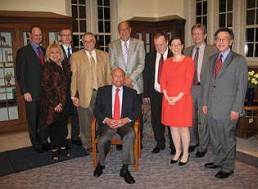
On the Friday evening, before the Exhibition Opening, we were guests of Xavier University for a Shabbat dinner hosted by Rabbi Abie Ingber.

The following day, Dr.Mitchel Livingston gave us a tour of Sigmund’s old alma mater, the University of Cincinnati.

On the morning of the Exhibition Opening, we were given a tour, by Dr Gary Zola, of the magnificent records held by the American Jewish Archives.
The Exhibition Album (First Edition)
The Exhibition Album (First Edition)
Below are PDF files of scans of the First Edition of the Album of the Exhibition
THE JEWS OF CZĘSTOCHOWA
EXISTENCE – HOLOCAUST – MEMORY
Thanks to Alan Silberstein for providing these files.
Part 9: Częstochowa at the Turn of the 20th Century (Częstochowa – Przełomu XIX i XX Wieku)
The Exhibits
The Exhibits
"The Jews of Częstochowa"
“One of Poland’s largest and most vibrant Jewish communities lived in Częstochowa up until the German invasion of Poland in September 1939 and the ensuing Holocaust. From the 18th Century, followers of traditional Judaism, Hasidic Jews, and Christians lived together in relative peace. Until its devastation, Częstochowa Jewry was renowned for its religious faith and academic advances. The massive deportations of Częstochowa Jews to the Treblinka death camp, September and October 1942, took a toll of 40,000 victims.
“Let history teach us tolerance, peaceful coexistence of nations and mutual understanding so that we know better our neighbours. Let us create something which will make us think deeply about the past and the future and will loudly announce that the future of Poland and of all other nations should and must be based on mutual understanding and tolerance.”
All photographs
on this page
were supplied by and
are copyright to

Alan Silberstein
They may not be
reproduced elsewhere
without prior permission.
From an Idea to a Reality
From an Idea to a Reality
by Professor Dr. hab. Jerzy Mizgalski
In the late 1990’s, I received a telephone call which completely surprised me. A pleasant sounding voice advised me that I was speaking with a person from Częstochowa, currently living in Venezuela, Professor Elżbieta Asz-Mundlak. She introduced herself as the great-niece of Częstochowa Chief Rabbi Nachum Asz. With great curiosity, I awaited our first meeting.
I suggested that we meet in my home, because my apartment was where my Jewish- related notes, archival material, literature and photographs are stored. I had already concerned myself with Jewish history issues for over ten years.
My extraordinary guest showed a great interest in the work which, together with my now-deceased colleagues, Dr Zbigniew Jakubowski, and Dr hab. Janusz Lipiec, I had undertaken since the early 1980’s.
Professor Asz-Mundlak  (pic right) raised the idea of making a documentary film about her unusual story as well as to describe her search for any traces that remained of her family and the Jewish community, following the tragedy of the Holocaust. Her enthusiasm spread to my colleagues. Jerzy Piwowarski, then Associate Dean of the Art Department of Jan Długosz University in Częstochowa, Jarosław Kweclich, head of that Department, then Archives Director, Elzbieta Surma-Jończyk plus the directors and staff of the Częstochowa Museum all joined into the project.
(pic right) raised the idea of making a documentary film about her unusual story as well as to describe her search for any traces that remained of her family and the Jewish community, following the tragedy of the Holocaust. Her enthusiasm spread to my colleagues. Jerzy Piwowarski, then Associate Dean of the Art Department of Jan Długosz University in Częstochowa, Jarosław Kweclich, head of that Department, then Archives Director, Elzbieta Surma-Jończyk plus the directors and staff of the Częstochowa Museum all joined into the project.
The intensity of my work on this project led me to search the Public Archives in Częstochowa, Kielce and Łódz, the Jewish Historical Institute in Warsaw, as well as the Archiwum Akt Nowych (New Records Archive) of Warsaw. As the data collected grew, the information gathered regarding the Jewish community of Częstochowa in the 19th and earlier 20th centuries broadened.
Together with Elzbieta, we came to the conclusion that the subject required wider study and was of such interest that it could not be accurately represented in just one film.
Elżbieta made her documentary film entitled “I Was Lucky: A Lesson in History”. In the film, she presented the dramatic circumstances of her childhood when, as a little girl from the Jewish ghetto, she found protection with the Nazarene Sisters and then with the Catholic Częstochowa Zieliński a family.

 During Elżbieta’s next visit to Częstochowa, I had the pleasure to meet with another former Jewish resident of Częstochowa who, like her, had the good fortune to have survived the hell of the ghetto and HASAG. Sigmund Rolat (pic left) and his cousin, Alan Silberstein (pic right), were extremely interested in the research material that we had collected and acquainted themselves with our planned project – a museum exhibition which, at the time, went under the working title of The World of Nachum Asz. From that meeting, the work took on an even greater tempo and the scope of the endeavour changed.
During Elżbieta’s next visit to Częstochowa, I had the pleasure to meet with another former Jewish resident of Częstochowa who, like her, had the good fortune to have survived the hell of the ghetto and HASAG. Sigmund Rolat (pic left) and his cousin, Alan Silberstein (pic right), were extremely interested in the research material that we had collected and acquainted themselves with our planned project – a museum exhibition which, at the time, went under the working title of The World of Nachum Asz. From that meeting, the work took on an even greater tempo and the scope of the endeavour changed.
Sigmund turned out to be an amazing man who, as a Częstochowiańin, was visiting his home city after many years and was treating his stay, not only as a return to memories and to his childhood and youth, but also as an opportunity to concern himself with everything that was happening today in Częstochowa. There were many emotional moments. For me, the most inspirational were my discussions with him.
The work surrounding the undertaking “The Jews of Częstochowa – Coexistence, Holocaust, Memory” attracted the interest of the city authorities who offered assistance in various ways. In discussions with students, either privately or with students and teachers in schools, I was bombarded with questions about how the preparatory work on the Exhibition was progressing. Sometimes, it gave me the feeling that this was the next “miracle” under Jasna Góra of John Paul II’s – that two communities, Christian and Jewish, together were creating reflections of their common city’s history.
This reflection on the past became a point of departure for us, who were required to reflect more deeply. Documentary evidence of events and historic facts would determine the narrative of the coexistence, the tolerance and the inter-penetration of cultures as conditioning factors on the progress of civilization. Extensive research in archives and libraries, especially that undertaken in Częstochowa, would answer the basic question:
which had co-existed here for over 200 years?”
“What is the current relationship of the inhabitants of Częstochowa to the Jews, especially those who,
due to the tragic years of the Holocaust, left never to return?”
A meeting of history with the current situation became a lesson for those Jews who arrived from around the world as well as for contemporary Częstochowiańin. Those who, with ill-will hovered here and there in oral history, had to give way to a rational view of relations between the two nations – Polish and Jewish.
“Days of Remembrance – The Jews of Częstochowa”, cultural events created in this city for the first time on so wide a scale after the great tragedy of the Holocaust, would serve the idea of building future societies on foundations of the memory of past historical events. Mutual recognition, as regards to past Częstochowa communities, both Polish and Jewish, was the thread that determined coexistence and tolerance.
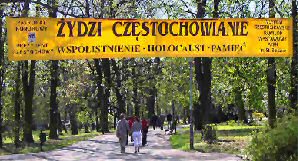 The three days (21st-23rd April 2004) of cultural events, meetings and remembrances were something more for the Jewish visitors from all continents of the world, whose family-roots and even childhood is united “from under the cloisters of Jasna Góra” with the city, with the centre of Catholic religious life in Poland and known as such worldwide.
The three days (21st-23rd April 2004) of cultural events, meetings and remembrances were something more for the Jewish visitors from all continents of the world, whose family-roots and even childhood is united “from under the cloisters of Jasna Góra” with the city, with the centre of Catholic religious life in Poland and known as such worldwide.
It was a return to the years of their youth and their childhood, when they still felt the care of their mothers, fathers, times with brothers, sisters, cousins, traditional family gatherings during Jewish religious holidays. Streets, houses, the Jewish cemetery – all evoke memories that are painful – of what has gone forever.
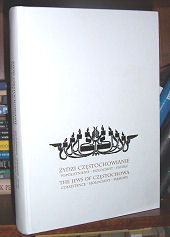 I also had the honour to edit the Exhibition’s album in cooperation with other staff of the Jan Długosz University, the State Archives in Częstochowa and the Jewish Historical Institute in Warsaw, who collected the material for the exhibition itself. Together with the exhibition, the album provides an overall essence. Each of its parts correspond with the arrangement of the material displayed in the exhibition.
I also had the honour to edit the Exhibition’s album in cooperation with other staff of the Jan Długosz University, the State Archives in Częstochowa and the Jewish Historical Institute in Warsaw, who collected the material for the exhibition itself. Together with the exhibition, the album provides an overall essence. Each of its parts correspond with the arrangement of the material displayed in the exhibition.
 At 4.00pm, in Św.Stasic Park, in the exhibition hall of the Museum of Częstochowa, the exhibition, “The Jews of Częstochowa” was opened. It was a co-operative effort between the staff of the Jan Długosz University in Częstochowa, the State Archive in Częstochowa, the Museum of Częstochowa and the Jewish Historical Institute in Warsaw.
At 4.00pm, in Św.Stasic Park, in the exhibition hall of the Museum of Częstochowa, the exhibition, “The Jews of Częstochowa” was opened. It was a co-operative effort between the staff of the Jan Długosz University in Częstochowa, the State Archive in Częstochowa, the Museum of Częstochowa and the Jewish Historical Institute in Warsaw.
The exhibition’s Official Opening was attended by many honoured guests. Among those gathered inside and in front of the building’s entrance were many conference attendees and a great number of city’s residents.
Written by:

Prof. Dr. Hab. Jerzy Mizgalski
Historian,
former Vice-Chancellor of the
Jan Długosz University and
one of our Exhibition’s creators.




